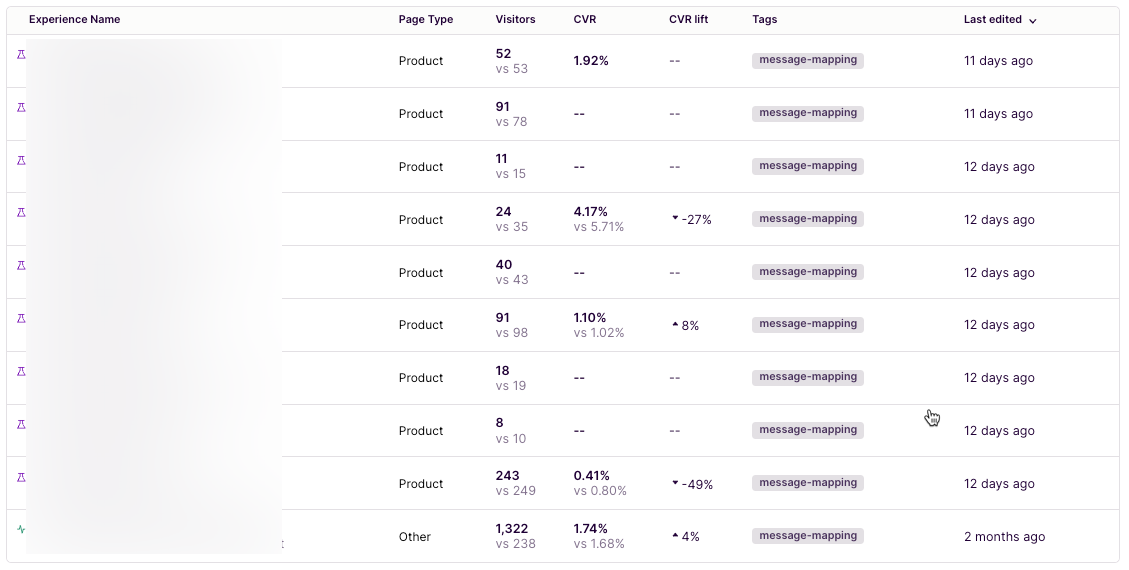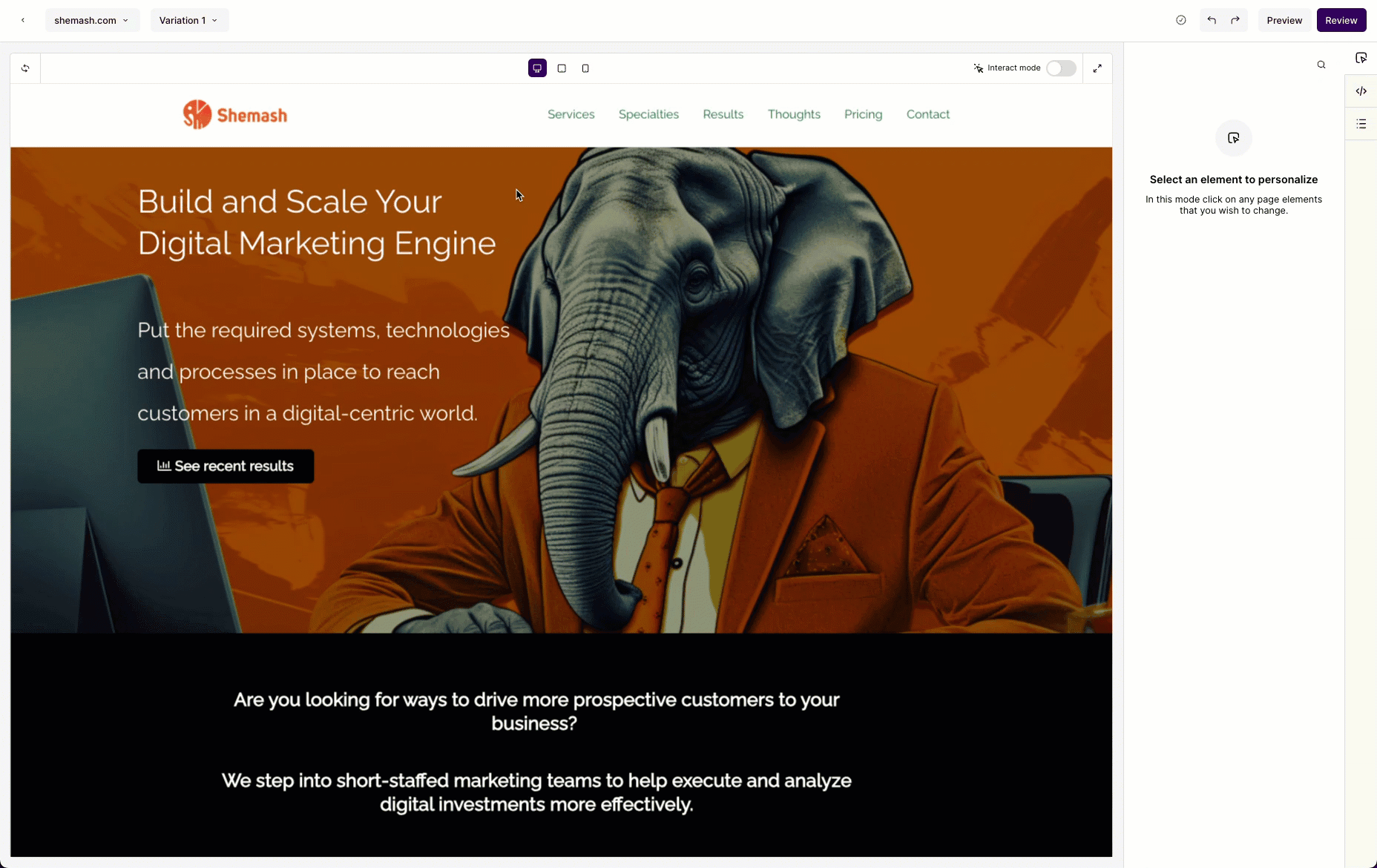
B2B Dynamic Website Personalization
One area of conversion optimization we really believe in here at Shemash is dynamic website personalization. We’ve been using it for a long time, first in a more rudimentary way with dynamic keyword insertion based on paid search traffic, but now layering that tactic (what we call message mapping) with several other personalization methods. Partly because these types of dynamic personalization platforms have advanced so much in their capacity over the past 10 years.
Where we started with Unbounce, we are now a big fan of Mutiny. And there are others in our wheelhouse like VWO and Optimonk. They all work somewhat the same but we’ll be using Mutiny in the discussion and examples that follow.
Why Personalize Your B2B Website
Selfishly, dynamic personalization is generally considered a sub-tactic of conversion rate optimization, helping to drive more people to your desired site/app engagements and conversions.
However, when done with greater detail and planning, dynamic personalization is a benefit to your visitors and prospective customers, as well. If your personalization engine can better predict and surface the content they are most likely wanting, you’re making their life easier. They’ll get the information they are looking for and you’ll have made it simpler to find.
Because these newer platforms on the market, like Mutiny, give you both advanced segmentation as well as content editing features, your customer’s journey through your site will be a more streamlined experience. While there are still ways to go and limitations across tools, there are great gains to be found that benefit your customers as well as your business.
Way to Use Dynamic Personalization
There are countless ways you can slice and dice your audience segmentation and content personalization. The scope of all of these combinations is far beyond what I’m going to share here. However, I wanted to give you a few examples of what we do for our clients with Mutiny.
Message Mapping
Don’t throw out what historical works just because it’s not a shiny and new tactic. We leverage message mapping for our Paid Search campaigns wherever possible. We prioritize by what utm_terms get the highest volume and then dynamically change various web copy on the landing page based on the search keyword driving the traffic.
Here are some fresh ones we just launched. Note they are 2 weeks old for the most part (at the time of writing this article) so no statistical significance. Results vary depending on the search keyword so we’ll let these ride for a while and make a call when we have more conclusive data.

Account-based Marketing
There are two main approaches to ABM personalization: inbound and outbound.
Inbound would detect if someone was a visitor from a target account and then change the site based on how you’ve customized the content of your landing page (or collection of important pages). Using a platform like Mutiny, you’d program the audience segmentation based on data from tools like 6Sense or Clearbit so that’s an extra piece to the puzzle to get this to work. Note: Mutiny is launching a beta feature I’ll be testing around improved ABM inbound experiences so will likely come back and update this section when I have more intel.
Outbound can help you create a whole collection of dedicated links by Account that dynamically change a singular landing page to be customized for each Account. A past example of how I did this was creating a dedicated, generic outbound ABM landing page. From there I had account executives mark a field called “Top Targets” in Salesforce. I then used Mutiny’s audience segmentation tool to dynamically bring in accounts that had this Top Target flag set to true.
Then, in the placeholder sections of the dedicated landing page, I’d use dynamic tokens to insert details about the account, putting their specific company name and logo into the hero section of the page. I’d then use some industry segmentation to change out content on the page based on the account’s industry.
After building and publishing this, dedicated landing page links automatically populated over to the account record in Salesforce for AEs and BDRs to copy and send to their prospects.
Testing CTAs
You can split-test CTAs or use dynamic ones in a variety of ways. A few good examples would be:
- Changing button text and the destination after they’ve engaged with the original button. Example: Perhaps you have a “product overview” button in the hero on your website. If you know someone has visited the details of that page, you can dynamically change that button the next time they see it go a step further in the journey, e.g. Pricing Details or Request a Demo. Think about your funnel and change the experience based on that data.
- Adding banners/side pops/exit intents for repeat visitors who haven’t completed your main conversion events to get them to prime content that helps them make a decision. CTAs to “See Pricing” work well to influence the customer journey and ultimately drive more conversions.
- Simple A/B split tests on the CTAs themselves, like changing the text (basic example below):

How to Measure Dynamic Personalization’s Value
Whether you are running these personalizations as tests or they receive the full possible traffic, platforms like Mutiny can measure conversion rates for each experience. You can build a collection of different conversions and measure each experience based on all of your conversions or the key one the experience is designed to influence. To go back to my basic button text example, I would set up a conversion to see how many people make it to the “Results” page. Then, I’d apply that conversion type to this split test to see if a simple language change can drive more people to the page. This is an extremely basic example for demonstration – but it applies to almost any level of complexity you have with dynamic personalization.
Taking it a step further, you could wire up key event tracking in something like Google Tag Manager and GA4 and then build reports, including funnels to measure performance in more depth. Keep in mind that you would want to pass event parameters, like the experience name/description so you can build more detailed funnels.
Personalization Methods I’m Still Looking For
This may be me just not having the full awareness of all of the available tools, but there are some things I have yet to see that would be a huge improvement for dynamic personalization. Variations of them may be baked into certain content management systems, but having all of your dynamic content programming under one platform would be ideal. Here are a couple I’d like to see (or find out exist already):
Predictive content delivery
We should be able to tag content blocks and leverage machine learning so that when a user does X, e.g. watches a specific video, the site changes on the fly without having to hard code segment and content customization. Even better would be to not require a page load for this dynamic change to occur. I believe this exists in some capacity (in CMSes like I mentioned) with “related content” components but I’ve yet to see them dynamically change like I’ve described.
The same goes if you’re in a B2C/eCommerce environment and related products but I don’t see too much intelligence behind these yet. An example here would be a visitor adds product A to the shopping cart and your e-commerce engine dynamically adds product suggestions based on recent sales where product A was purchased most commonly with the suggested products. Custom solutions may be able to do this, and of course, Amazon, does it, but are there out-of-the-box solutions in platforms like Shopify (for e-commerce) or WordPress/Webflow/Sitecore/AEM that can do that? Not sure – happy for someone to share that info with me.
Auto-AI Rewrites
Don’t get me wrong, AI writing has a long way to go but if an AI-based site personalization engine can learn from your brand and copy guidelines along with assess details about the site visit (e.g. source, keyword data), it’s not too far fetched for sections of a site to be dynamically re-written to combine this intelligence into smart, compelling copy. This takes us away from all of the manual message mapping we’ve had to do historically and helps with automated personalized experiences.
Next Steps
I hope that gives you a little more insight into dynamic website personalization for B2B. There are plenty of tools on the market to do this. Some features may exist in your current CMS while others may come from using tools like Mutiny, VWO, Optimonk, and others.
If you want to chat about how you can implement something like this or go deeper on the ideas presented here, please feel free to reach out either on LinkedIn or our contact form.
